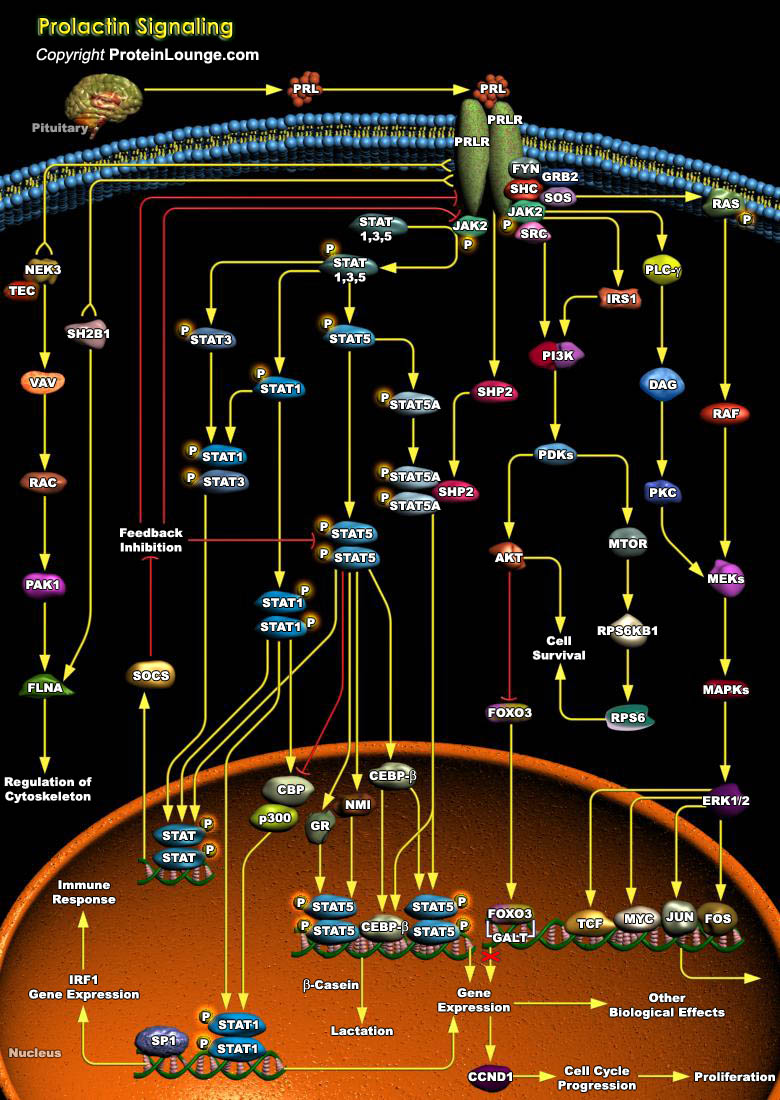
PRL (Prolactin), a multifunctional hormone secreted by the anterior pituitary gland and to a lesser extent by numerous extrapituitary tissues, affects more physiological processes than all other pituitary hormones combined. It was originally identified by its ability to stimulate the development of the mammary gland and lactation. However, this hormone has been established to be present in all vertebrates, and involved in more than 300 separate effects, which can be ascribed to six broad categories: (i) reproduction and lactation, (ii) growth and development, (iii) endocrinology and metabolism, (iv) brain and behaviour, (v) immunomodulation and (vi) osmoregulation. It acts as a pleiotropic cytokine promoting cellular proliferation and differentiation of a variety of[..]
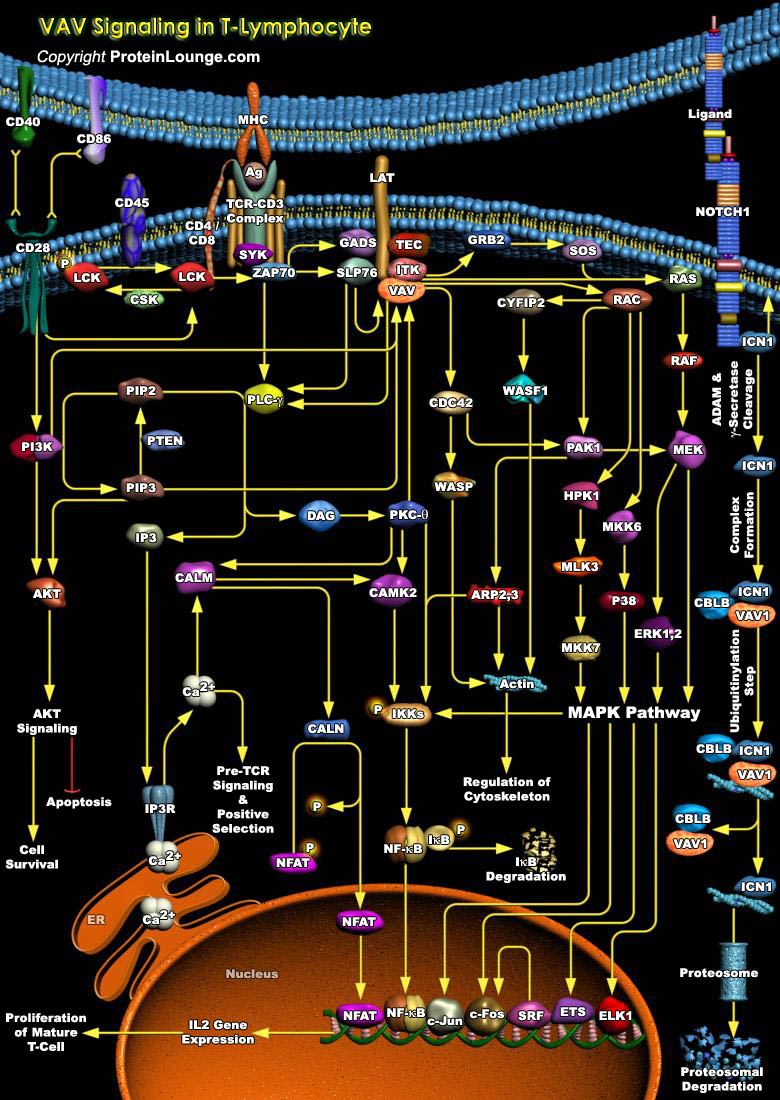
VAV(Oncogene Vav) family of proteins act as GEFs (Guanine Nucleotide Exchange Factors) and activators of Rho family GTPases, and are known to orchestrate cytoskeletal changes and cell migration in response to extracellular stimuli by catalyzing the exchange of GDP for GTP. Of the three mammalian isoforms, Vav1 is primarily expressed in hematopoietic cells, while Vav2 and Vav3 are more ubiquitously expressed. VAV proteins are found in the cytoplasm of resting lymphocytes, and TCR (T Cell Receptor)/CD3 (CD3 Antigen) stimulation cause their translocation to the plasma membrane, presumably because of recruitment to either ZAP70 (Zeta-Chain-Associated Protein Kinase) or to the LAT (Linker for Activation of T-Cells)-SLP76 (SH2 Domain-Containing Leukocyte Protein-76) complex[..]
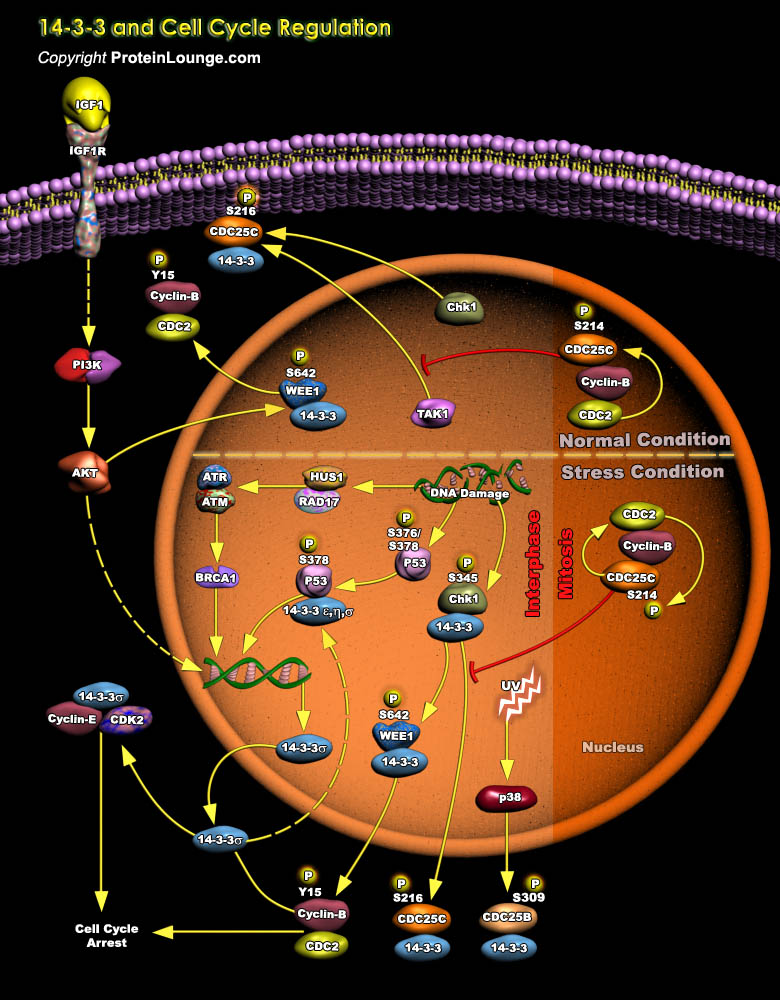
Co-ordinated progression through the cell cycle is essential for the maintenance of genomic integrity. 14-3-3 proteins play particularly important roles in coordinating progression of cells through the cell cycle, regulating their response to DNA damage, and influencing life-death decisions following internal injury or external cytokine-mediated cues. 14-3-3 proteins function at several key points in G1/S- and G2/M-transition by binding to regulatory proteins and modulating their function. The association with 14-3-3 proteins requires a specific phosphorylation of the protein ligand and mediates cell cycle arrest. 14-3-3 binding may lead to cytoplasmic sequestration of the protein ligand but may also have other functional consequences (Ref.1 and 2).14-3-3 proteins[..]
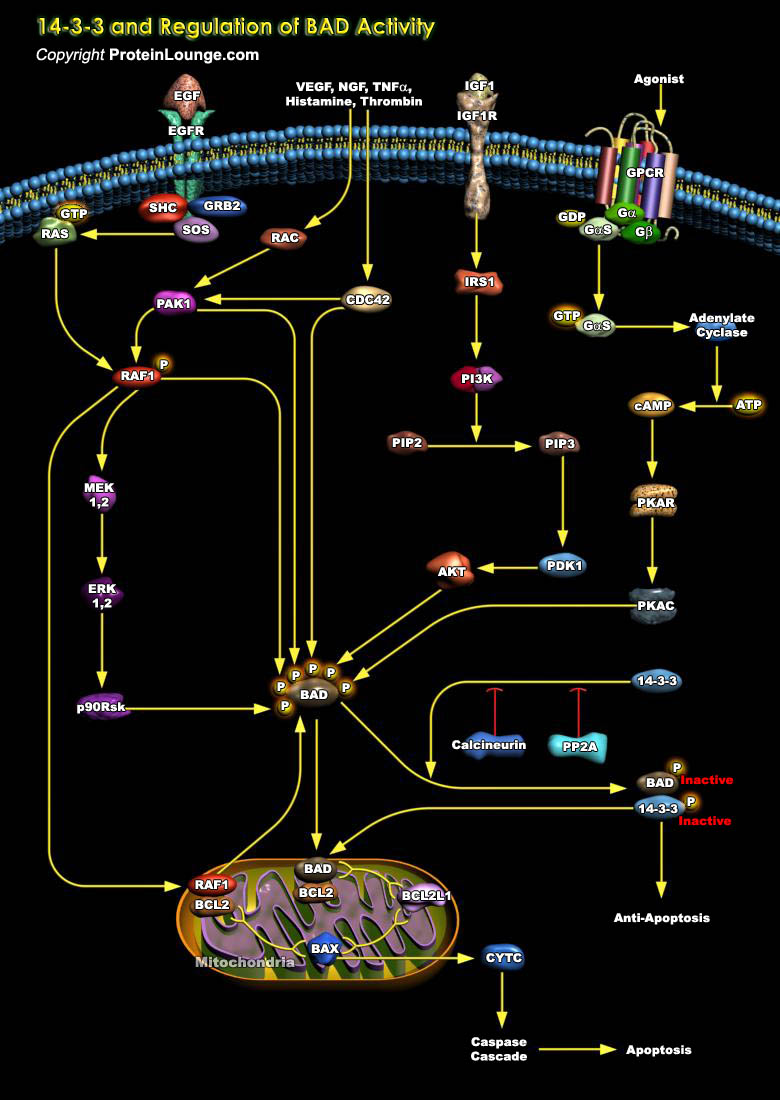
14-3-3 is a phosphoserine/phosphothreonine-binding protein that is being implicated in a wide range of cellular phenomena. 14-3-3 family members are found in all eukaryotes – from plants to mammals – and more than 100 binding partners have been identified to date. They regulate their activities by a number of different mechanisms, which include inter- and intracompartmental sequestration, activation/inactivation of enzymatic activity and promotion/inhibition of protein interactions. The targets of 14-3-3 are found in all sub cellular compartments and their functional diversity is overwhelming – they include transcription factors, biosynthetic enzymes, cytoskeletal proteins, signaling molecules, apoptosis factors and tumor suppressors (Ref.1 & 2).[..]
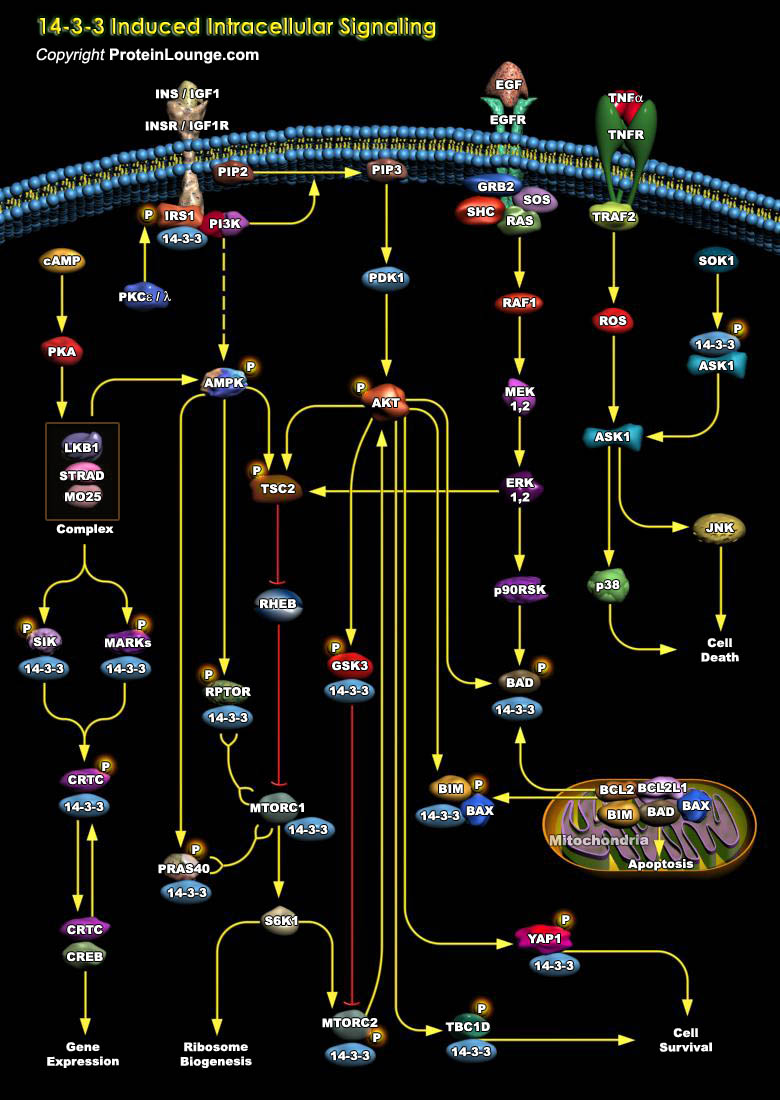
The 14-3-3 family of proteins consists of molecular adaptors that recognize phosphorylated proteins (e.g. kinases, transcription factors and receptors). They are able to coordinate almost limitless combinations of protein complexes, which accounts for their functional diversity (Ref.1). This plethora of interacting proteins allows 14-3-3 to play important roles in a wide range of vital regulatory processes, such as neuronal development, mitogenic signal transduction, apoptotic cell death, cell cycle control, cell growth control, and viral and bacterial pathogenesis. More than 50 signaling proteins have been reported as 14-3-3 ligands (Ref.1). Seven mammalian isoforms of 14-3-3 proteins (α/β, ɛ, η, γ, τ/θ, δ/ζ, σ) have[..]
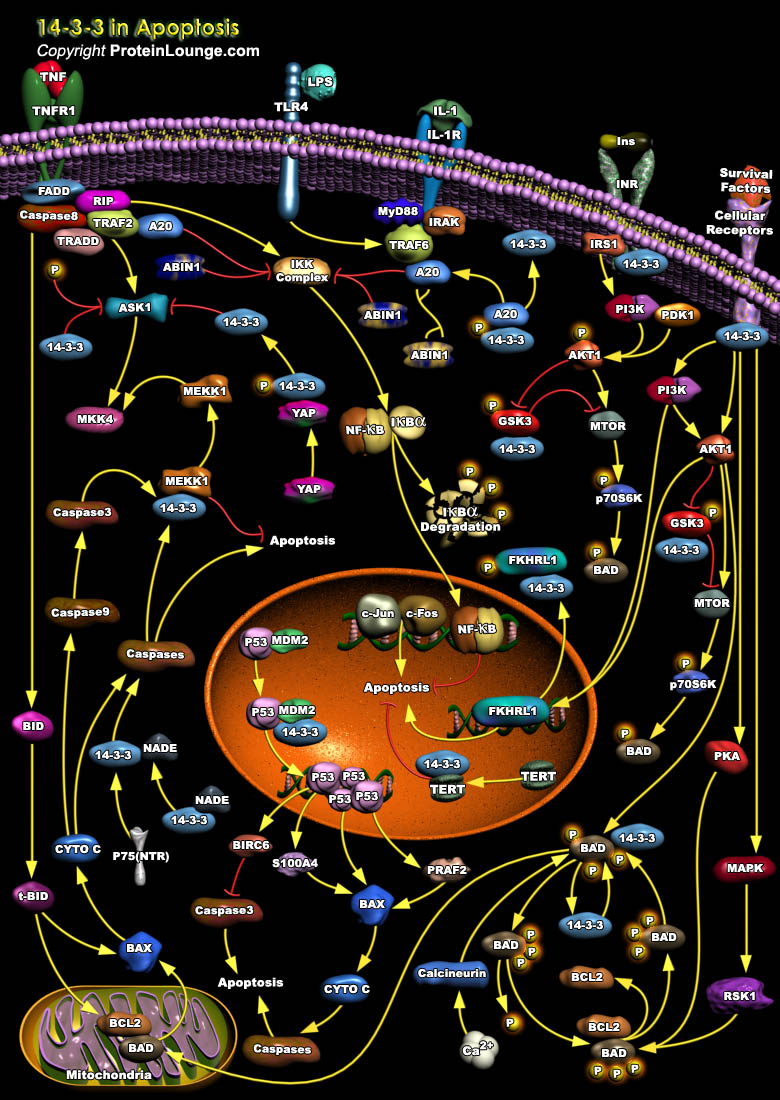
14-3-3 proteins are abundantly expressed adaptor proteins that interact with a vast number of binding partners to regulate their cellular localization and function. They regulate substrate function in a number of ways including protection from dephosphorylation, regulation of enzyme activity, formation of ternary complexes and sequestration. They are key regulators of major cellular processes such as proliferation, differentiation, senescence and apoptosis (Ref.1 and 2). Apoptosis is a physiological process of cell death that plays a critical role in normal development as well as in the pathophysiology of a variety of diseases. The fundamental cellular mechanism behind apoptosis is due to a balance between anti-apoptotic and pro-apoptotic factors, which may be shifted[..]
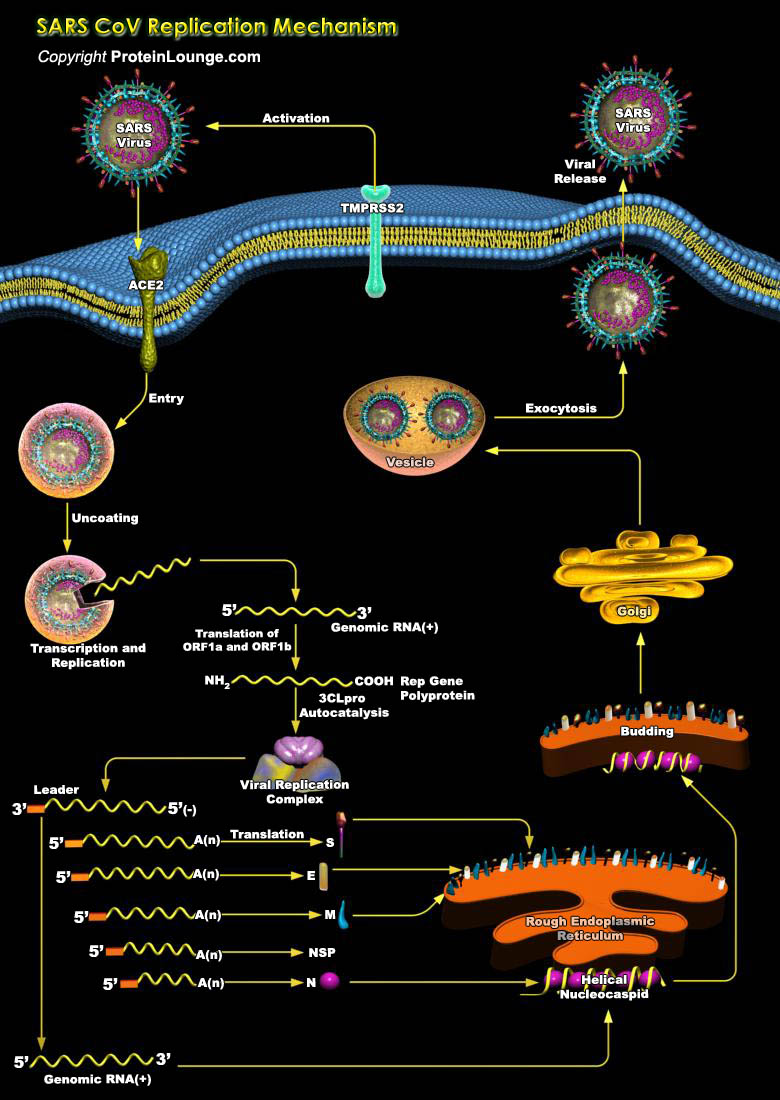
SARS (Severe Acute Respiratory Syndrome) is a newly emerged infection in humans characterized by fever and pneumonia. This disease may progress rapidly to ARDS (Acute Respiratory Distress Syndrome) with considerable morbidity and mortality. It was first identified in the Guandong Province of China in November 2002, and a major outbreak occurred in Hong Kong in March 2003 (Ref.1). Probable cases have been reported in 31 countries, with extensive ongoing transmission in Taiwan and China, continuing transmission in Hong Kong, and major outbreaks that are now under control in Singapore and Vietnam. There are three different phases of SARS, with symptoms including fever, a dry cough, dyspnea (shortness of breath), headache, and hypoxaemia (low blood oxygen concentration).[..]
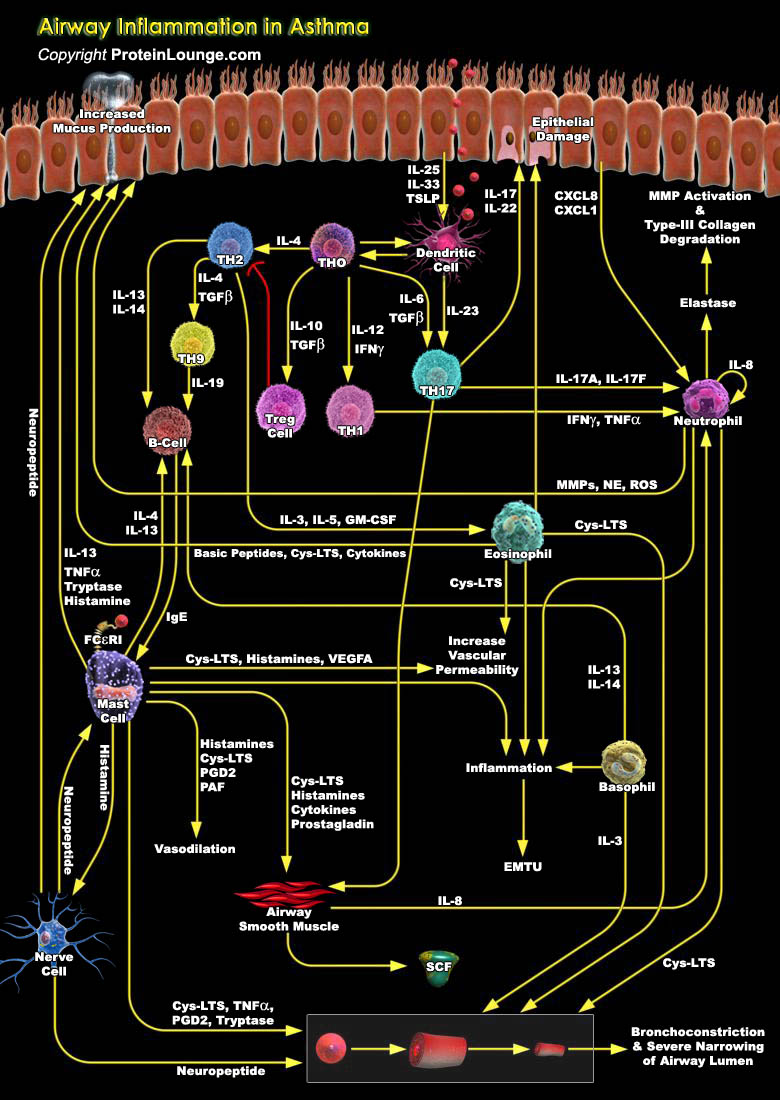
Asthma is a complex, chronic inflammatory lung disease which is characterized by persistent airway inflammation and airway wall remodeling, that includes the structural changes in the airway wall, epithelial cell shedding, hyperplasia and hypertrophy of the ASM (airway smooth muscle) bundles, basement membrane thickening and increased vascular density. Airway wall remodeling starts early in the pathogenesis of asthma [Ref.1]. It originates from complex interactions between genetic factors and environmental agents such as aeroallergens and respiratory viruses [Ref.2]. In the airway lumen, TSLP, IL-25, and IL-33 acts directly on dendritic cells and then it processes the antigenic molecules and present them to Th0 (naïve T helper cells) [Ref.3]. Further, Th0 get[..]
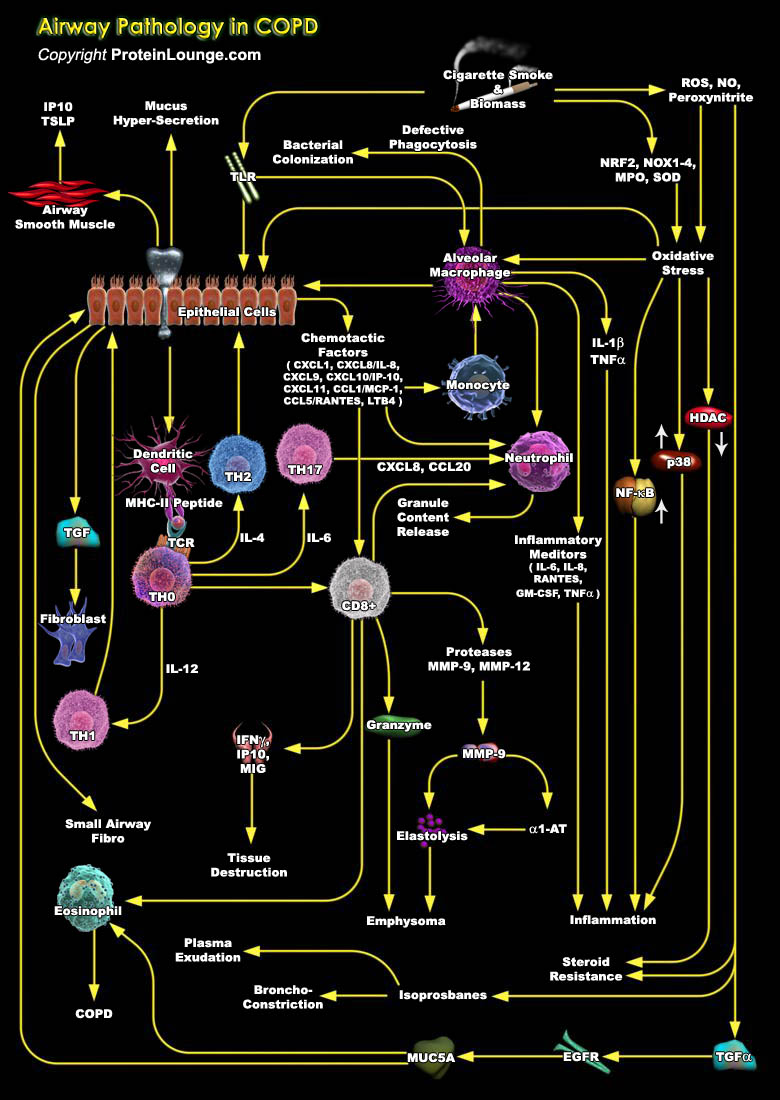
Chronic obstructive pulmonary disease (COPD) is a major global health problem that is becoming preva¬lent, particularly in developing countries [Ref.1]. It is one of the most common diseases in the world, with a lifetime risk estimated to be as high as 25%, and now equally affects both men and women [Ref.2]. COPD is greatly under¬ diagnosed and often diagnosed late in its course, so there are vigorous attempts to increase awareness of this dis¬ease and to promote the use of spirometry to identify more patients [Ref.3]. COPD involves chronic inflammation of the periph-eral airways and lung parenchyma, which leads to pro¬gressive narrowing of the airways and shortness of breath [Ref.4.]Cigarette smoke (and other irritants) activates macrophages and[..]
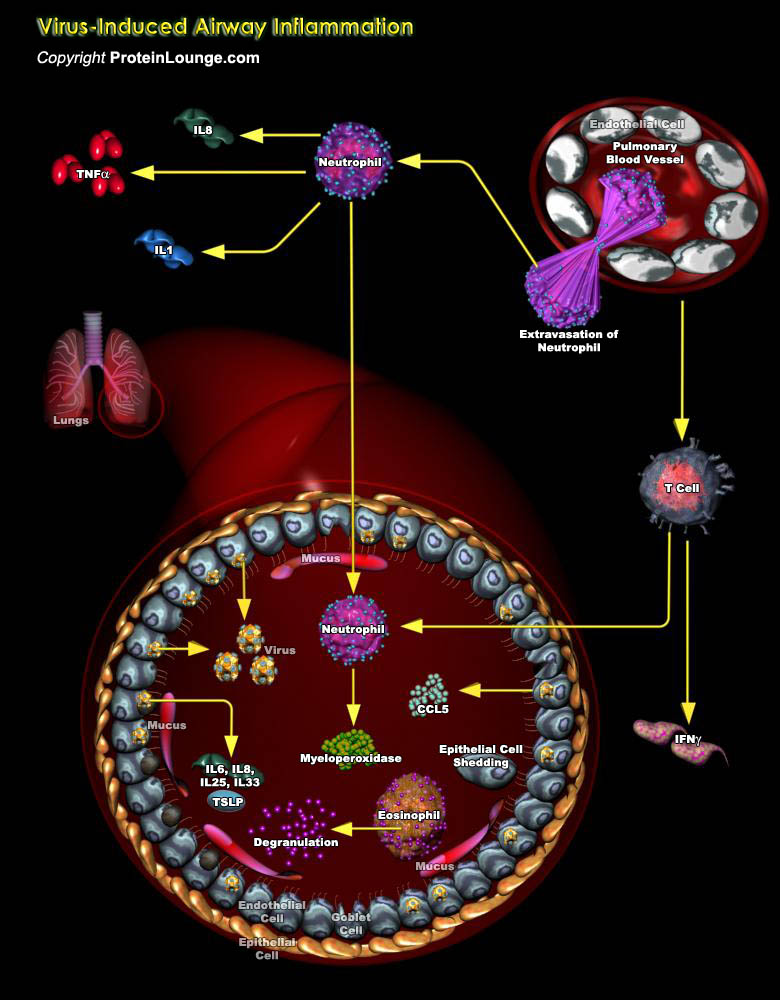
More than 200 different types of viruses, such as human Rhinovirus (HRV), human Metapneumovirus (HMPV), Respiratory Syncytial Virus (RSV), and human Parainfluenza Virus (HPIV), are known to cause acute respiratory illness. Virus-induced cytokine production and inflammatory cell activation are instrumental in the development of neurogenic inflammatory responses, and these combined factors increase bronchoconstriction in response to allergens or irritants. Respiratory viruses primarily infect and replicate within airway epithelial cells. During the replication process, the cells release antiviral factors and cytokines that alter local airway inflammation and airway niche. In a healthy airway, the inflammation normally leads to type 1 inflammatory responses consisting of[..]
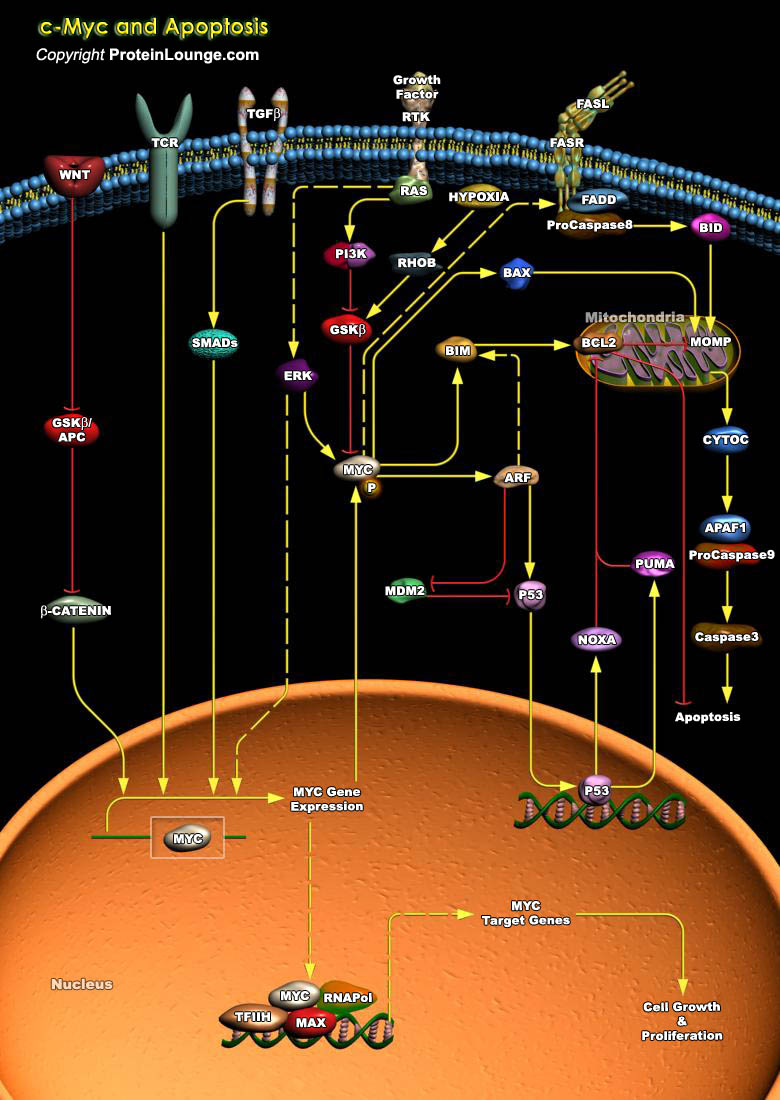
Many proto-oncogenes participate in the regulation of apoptosis and closely intertwined with their actions are various growth factors and other genes that participate in the control of cellular growth. The proto-oncogene c-Myc encodes a transcription factor c-Myc that plays a critical role in multiple cellular processes including cell growth, proliferation, differentiation, and apoptosis. Expression of c-Myc is rapidly induced by mitogens and is down regulated during differentiation. c-Myc activity is sufficient to drive cells into the cell cycle in the absence of growth factors but also induces apoptosis when survival factors are missing. Deregulated expression of c-Myc is associated with a wide array of human cancers. Thr-58 is a major phosphorylation site in c-Myc[..]
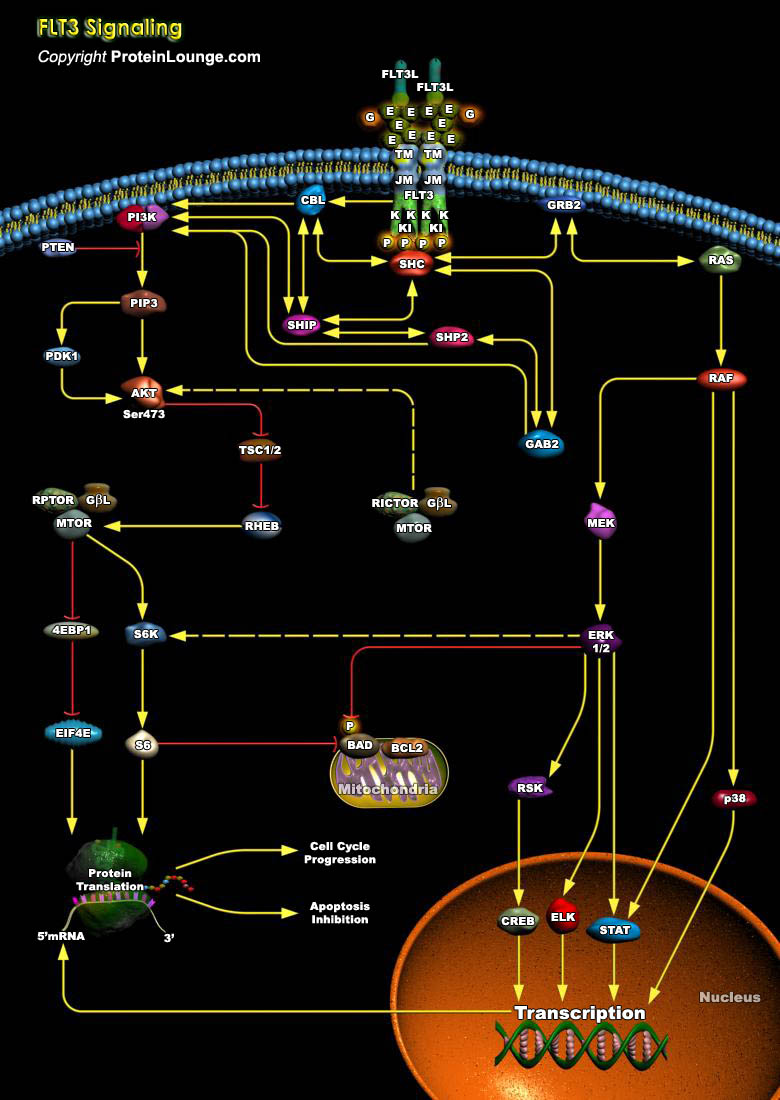
FLT3 (Fms-like Tyrosine Kinase-3), also known as FLK2 (Fetal Liver Kinase-2) and STK1 (human Stem Cell Kinase-1) was originally isolated as a hematopoietic progenitor cell-specific kinase, and belongs to the Class-III RTK (Receptor Tyrosine Kinase) family to which c-Fms, c-Kit, and the PDGFR (Platelet Derived Growth Factor Receptor) also belong (Ref.1). Normal expression of FLT3 is restricted to haemopoietic progenitor cells in the bone marrow, thymus and lymph nodes, but is also found on other tissues such as placenta, brain, cerebellum and gonads. Aberrantly expressed FLT3 is observed at high levels in a spectrum of hematologic malignancies including 70% to 100% of AML (Acute Myelogenous Leukemia), B-precursor cell ALL (Acute Lymphoblastic Leukemia), a fraction of[..]

